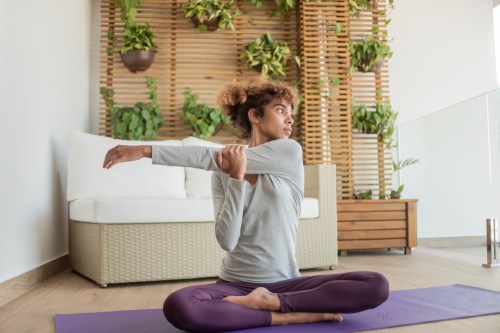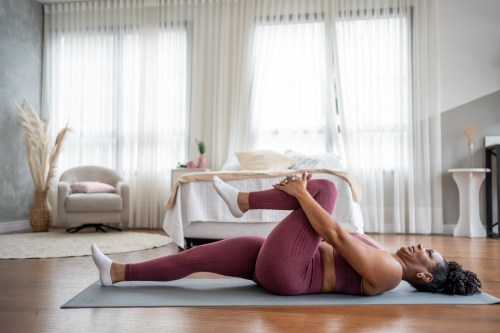3 podiatrist-approved plantar fasciitis stretches to combat WFH-induced heel pain
Walking around barefoot all day could leave you with a *lot* of pain in your heels. These three podiatrist-approved plantar fasciitis stretches can help.

One of the many benefits of working from home is that you literally never have to put on shoes. It’s totally acceptable to do everything barefoot, including going to “work” (aka the couch near where your laptop is plugged in), walking to the refrigerator, and working out. But according to podiatrists, allowing your shoes to collect dust during quarantine may not be the best idea for the health of your feet. And one of the most insidious (read: painful and annoying) side effects that can occur? A condition called plantar fasciitis.
If you’ve got a stabbing pain in the bottom of your foot any time you stand up, plantar fasciitis—which is the most common cause of heel pain—is likely to blame. “The plantar fascia is a shock-absorbing bowstring like thick ligament that connects your heel to toes,” explains podiatrist Miguel Cunha, MD, Founder of Gotham Footcare. “When you stand your arch collapses causing this bowstring to stretch out leading to the formation of micro tears in the ligament that can result in weakness, swelling, and irritation of the plantar fascia.”
This issue has become increasingly common in our new #noshoes way of life, because according to Dr. Cunha, “walking barefoot on hard surfaces allows our foot to collapse which can lead to a tremendous amount of stress not only to the foot but to the rest of the body.” Our feet pronate naturally when we walk with or without shoes, but when we walk barefoot for long periods of time it “alters the biomechanics and distribution of pressure and weight across the foot,” he explains.
And if you’re doing your at-home workouts sans sneakers, you’re likely compounding the problem even further. “Barefoot exercises are almost worse than walking barefoot as you’re putting more strain on your plantar fascia,” says Dr. Cunha.
The good news is that there are a number of ways you can deal with the issue on your own, without having to take a trip to the podiatrist’s office. Dr. Cunha suggests freezing a water bottle, and rolling your foot back and forth over it for 20 minutes, three times a day. Topical and oral anti-inflammatories, like CBD and good, old-fashioned Advil, can help, too.
Stretching the area is also critically important, not just for your foot but for the muscles around it, too. “I recommend stretching not just the plantar fascia but also the Achilles tendon which can oftentimes be the culprit,” says Dr. Cunha. “Tightness of the Achilles tendon can limit ankle range of motion which can place added stress onto the plantar fascia.” Here, he shares three plantar fasciitis stretches that can help.
1. Standing achilles stretch: Standing in front of a wall, place your toes on the wall with your heel planted on the floor. Keeping your knee and leg extended, bring your hips toward the wall, and you’ll feel the stretch down the back of your heel.
2. Seated achilles stretch: Sit on the floor with your legs outstretched in front of you, and wrap a towel, belt, or band around your toes. Holding the ends in either hand, pull your toes back toward you, keeping your legs extended.
3. Plantar fascia stretch: Sit with your legs crossed, and place the painful foot onto your opposite knee. Use your hand to bend your toes, and massage the arch by kneading it with your thumb. Apply deep pressure, dragging your thumb along the course of the plantar fascia from your heel toward your toes. Repeat five times daily, and be sure to ice the area frequently.
Your feet aren’t the only thing you should be giving a little extra love to right now. Here’s why it’s important to practice good wrist posture, and why you should be wringing out your neck with CARS stretches on the regular.
Sign Up for Our Daily Newsletter
Get all the latest in wellness, trends, food, fitness, beauty, and more delivered right to your inbox.
Got it, you've been added to our email list.










